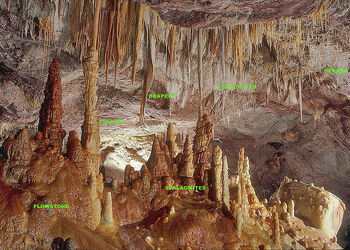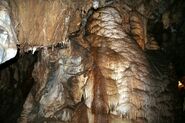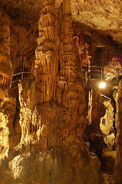
Image showing the six most common speleothems with labels. Enlarge to view labels.
A speleothem (pronounced /ˈspiːliːɵθɛm/; from the Greek for "cave deposit"), commonly known as a cave formation, is a secondary mineral deposit formed in a cave. Speleothems are typically formed in limestone or dolostone solutional caves.
Origin and composition[]
Water seeping through cracks in a cave's surrounding bedrock may dissolve certain compounds, usually calcite and aragonite (both calcium carbonate), or gypsum (calcium sulfate). The rate depends on the amount of carbon dioxide held in solution, on temperature, and on other factors. When the solution reaches an air-filled cave, a discharge of carbon dioxide may alter the water's ability to hold these minerals in solution, causing its solutes to precipitate. Over time, which may span tens of thousands of years, the accumulation of these precipitates may form speleothems.
Types and categories[]
Speleothems take various forms, depending on whether the water drips, seeps, condenses, flows, or ponds. Many speleothems are named for their resemblance to man-made or natural objects. Types of speleothems include:
- Dripstone is calcium carbonate in the form of stalactites or stalagmites:
- Stalactites are pointed pendants hanging from the cave ceiling, from which they grow;
- Soda straws are very thin but long stalactites having an elongated cylindrical shape rather than the usual more conical shape of stalactites;
- Helictites are stalactites that have a central canal with twig-like or spiral projections that appear to defy gravity;
- Include forms known as ribbon helictites, saws, rods, butterflies, "hands", curly-fries, and "clumps of worms"
- Chandeliers are complex clusters of ceiling decorations;
- Stalagmites are the "ground-up" counterparts of stalactites, often blunt mounds;
- Broomstick stalagmites are very tall and spindly
- Totem pole stalagmites are also tall and shaped like their namesakes
- Fried Egg stalagmites are small, typically wider than they are tall
- Columns result when stalactites and stalagmites meet or when stalactites reach the floor of the cave;
- Stalactites are pointed pendants hanging from the cave ceiling, from which they grow;
- Flowstone is sheet like and found on cave floors and walls:
- Draperies or curtains are thin, wavy sheets of calcite hanging downward;
- Bacon is a drapery with variously colored bands within the sheet;
- Rimstone dams, or gours, occur at stream ripples and form barriers that may contain water;
- Stone waterfall formations simulate frozen cascades
- Draperies or curtains are thin, wavy sheets of calcite hanging downward;
- Cave crystals:
- Dogtooth spar are large calcite crystals often found near seasonal pools;
- Frostwork is needle-like growths of calcite or aragonite;
- Moonmilk is white and cheese-like;
- Anthodites are flower-like clusters of aragonite crystals
- Speleogens (technically distinct from speleothems) are formations within caves that are created by the removal of bedrock, rather than as secondary deposits. These include:
- Pillars
- Scallops
- Boneyard
- Boxwork
- Others:
- Cave popcorn, or cave coral, are small, knobby clusters of calcite;
- Cave pearls are the result of water dripping from high above, causing small "seed" crystals to turn over so often that they form into near-perfect spheres of calcium carbonate;
- Snottites are colonies of predominantly sulfur oxidizing bacteria and have the consistency of "snot", or mucus;[1]
Speleothems may also occur in lava tubes. Although sometimes similar in appearance to speleothems in caves formed by dissolution, these are formed by the cooling of residual lava within the lava tube.
Speleothems formed from salt, sulfur and other minerals are also known.
Speleothems made of pure calcium carbonate are a translucent white color, but often speleothems are colored by minerals such as iron, copper or manganese, or may be brown because of mud and silt particulate inclusions.
Chemistry[]
Many factors impact the shape and color of speleothem formations including the rate and direction of water seepage, the amount of acid in the water, the temperature and humidity content of a cave, air currents, the above ground climate, the amount of annual rainfall and the density of the plant cover. Most cave chemistry revolves around calcite; CaCO3, the primary mineral in limestone. It is a slightly soluble mineral whose solubility increases with the introduction of carbon dioxide, CO2. It is paradoxical in that its solubility decreases as the temperature increases, unlike the vast majority of dissolved solids. This decrease is due to interactions with the carbon dioxide, whose solubility is diminished by elevated temperatures; as the carbon dioxide is released, the calcium carbonate is precipitated.
Most other solution caves that are not composed of limestone or dolostone are composed of gypsum (calcium sulfate), the solubility of which is positively correlated with temperature.
As climate proxies[]
Samples can be taken from speleothems to be used like ice cores as a proxy record of past climate changes.[2] A particular strength of speleothems in this regard is their unique ability to be accurately dated over much of the late Quaternary period using the uranium-thorium dating technique. Stalagmites are particularly useful for palaeoclimate applications because of their relatively simple geometry and because they contain several different climate records, such as oxygen and carbon isotopes and trace cations. These can provide clues to past precipitation, temperature, and vegetation changes over the last ~ 500,000 years.
Absolute dating[]
- Main article: Absolute dating
Another dating method using electron spin resonance (ESR) — also known as electron paramagnetic resonance (EPR) — is based on the measurement of electron-hole centers accumulated with time in the crystal lattice of CaCO3 exposed to natural radiations. In principle, in the more favorable cases, and assuming some simplifying hypotheses, the age of a speleothem could be derived from the total radiation dose cumulated by the sample and the annual dose rate to which it was exposed. Unfortunately, not all the samples are suited for ESR dating: indeed, the presence of cationic impurities such as Mn2+, Fe2+, or Fe3+, humic acids (organic matter), can mask the signal of interest, or interfere with it. Moreover, the radiation centers must be stable on geologic time, i.e., to have a very large lifetime, to make dating possible. Many other artifacts, such as, e.g., surface defects induced by the grinding of the sample can also preclude a correct dating. Only a few percents of the samples tested are in fact suitable for dating. This makes the technique often disappointing for the experimentalists. One of the main challenge of the technique is the correct identification of the radiation-induced centers and their great variety related to the nature and the variable concentration of the impurities present in the crystal lattice of the sample. ESR dating can be tricky and must be applied with discernment. It can never be used alone: "One date only is No date", or in other words, "multiple lines of evidence and multiple lines of reasoning are necessary in absolute dating". However, "good samples" might be found if all the selection criteria are met.[3]
Gallery[]
References[]
- ↑ Macalady, Jones and Lyon, 2008, Environmental Microbiology 9(6):1402-1414
- ↑ "Speleothem (Cave Deposit) Data". NOAA Paleoclimatology. National Climatic Data Center. http://www.ngdc.noaa.gov/paleo/speleothem.html. Retrieved 2010-06-30.
- ↑
ESR dating
Speleothem are similar to travertine in the way they form and in their composition but there are differences. [1]
- De Cannière, P.; Debuyst R., Dejehet F., Apers D., Grün R. (1986). "ESR dating: a study of 210Po-coated geological and synthetic samples". Nuclear Tracks and Radiation Measurements 11 (4-5): 211–220. doi:10.1016/1359-0189(86)90037-3.
- Grün, R. (1989). "Electron spin resonance (ESR) dating". Quaternary International 1 (1): 65. doi:10.1016/1040-6182(89)90010-4.
- Grün, R. (1989). "ESR dating for the early Earth". Nature 338 (6216): 543–544. doi:10.1038/338543a0.
- Hennig, G.J.; Grün R. (1983). "ESR dating in quaternary geology". Quaternary Science Reviews 2 (2-3): 157–238. doi:10.1016/0277-3791(83)90006-9.
- Ikeya, M. (1984). "Age limitation of ESR dating for carbonate fossils". Naturwissenschaften 71 (8): 421–423. doi:10.1007/BF00365890.
- Jonas, M. (1997). "Concepts and methods of ESR dating". Radiation Measurements 27 (5-6): 943–973. doi:10.1016/S1350-4487(97)00202-3.
- Nambi, K.S.V.; Aitkin M.J. (1986). "Annual dose conversion factors for TL and ESR dating". Archaeometry 28 (2): 202–5. doi:10.1111/j.1475-4754.1986.tb00388.x.
- Radtke, U.; Mangini A., Grün R. (1985). "ESR dating of marine fossil shells". Nuclear tracks and radiation measurements 10 (4-6): 879–884. doi:10.1016/0735-245X(85)90103-6.
- Radtke, U.; Grün R. (1988). "ESR dating of corals". Quaternary Science Reviews 7: 465–470. doi:10.1016/0277-3791(88)90047-9.
- Rink, W.J. (1997). "Electron spin resonance (ESR) dating and ESR applications in quaternary science and archaeometry". Radiation Measurements 27 (5-6): 975–1025. doi:10.1016/S1350-4487(97)00219-9.
- Sato, T. (1982). "ESR dating of planktonic foraminifera". Nature 300 (5892): 518–521. doi:10.1038/300518a0.
- Skinner, A.R. (2000). "ESR dating: is it still an ‘experimental’ technique". Applied Radiation and Isotopes 52 (5): 1311–1316. doi:10.1016/S0969-8043(00)00089-0. PMID 10836448.
- V.A.Maltsev, C.A.Self. Cupp-Coutunn cave system, Turkmenistan, USSR // Proceedings of Bristol University speleological society, 1992, vol.19, p. 117-150.
- Self, Charles A.; Hill, Carol A. (2003). "How speleothems growth: An introduction to the ontogeny of cave minerals". Journal of Cave and Karst Studies 65 (2): 130–151. ISSN 1090-6924. http://www.caves.org/pub/journal/PDF/V65/v65n2-Self.pdf. Retrieved 2010-06-30</ref>
- Viktor A. Slyotov. Concerning the ontogeny of crystallictite and helictite aggregates of calcite and aragonite from the carst caves of Southern Fergana. «Cave Geology», vol. 2, Number 4, March 1999, p. 197-207 // USA, Petersburg, PA 16669-9211
External links[]
Template:Commons category
- The Virtual Cave: an online guide to speleothems
- Mineral aggregates from carst caves, formed in capillary film solutions
- Gallery of speleothems from NPS Cave and Karst Program
Template:Caves





